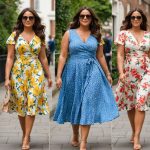Sustainable Fashion Content Creation
Incorporating sustainable fashion into content creation involves more than showcasing trendy outfits—it’s about sharing a story. Authentic storytelling is crucial in portraying the values and commitments of eco-friendly brands. By weaving narratives that highlight the journey and impact of using eco-friendly practices, creators can forge a genuine connection with audiences.
Crafting engaging content starts with understanding core values. Highlight the transformation of materials in sustainable fashion and outline how brands, by adopting green content creation, ensure environmental considerations are met at each step. This approach not only informs but can inspire readers to make conscientious choices.
Also to read : Discover the perfect blend: essential tips for selecting stylish and cozy home office outfits
Utilising sustainable fashion materials enhances the authenticity of blog visuals and supports the ethos the content embodies. Selecting visuals that reflect eco-friendly practices can amplify the message. These visuals might include images of ethically sourced textiles or snapshots of the sustainable processes involved in garment production.
To captivate your audience:
Also read : Top Must-Have Botanicals for Your Ultimate DIY Skincare Garden in the UK
- Emphasise the journey from raw material to finished product, embedding sustainable fashion principles.
- Showcase collaborations with other eco-friendly advocates, enhancing credibility and reach.
- Regularly update content to reflect new innovations in green content creation, ensuring relevance and continued engagement.
This method of content creation not only educates but motivates both creators and consumers to participate actively in the movement towards sustainability.
Ethical Brand Collaborations
In an age where consumers are increasingly focused on sustainability, ethical partnerships provide companies with a unique opportunity to enhance their brand image and generate long-term success. Ethical collaborations allow brands to align with shared values, increase mutual benefits, and remain relevant in the eyes of conscious consumers. But how do brands identify and engage in such partnerships effectively?
Identifying Compatible Brands
Finding the correct partner is crucial for any successful collaboration. Brands must seek others whose values align closely with their own. This is not just about sharing a commitment to sustainable practices, but also ensuring cultural and mission synergies. Conduct thorough vetting processes to spot potential red flags and secure collaborative marketing efforts that resonate with targeted audiences.
Crafting Value-Driven Partnerships
Once potential partners are identified, the next step is to craft partnerships that add value to all parties involved. This requires clear communication and negotiation to establish shared goals, responsibilities, and strategies. Fostering transparent dialogue encourages trust and commitment, creating a foundation for sustainable brands to thrive together.
Showcasing Ethical Collaborations
Highlighting successful collaborations can inspire others and elevate the participating brands’ public perception. By sharing stories and case studies of previous ethical partnerships, companies can demonstrate the impact and potential of collaborative efforts, both ethically and commercially.
Waste Reduction Techniques
In the quest for sustainable practices, bloggers can adopt numerous waste minimization strategies. One effective approach is repurposing both content and materials. For instance, bloggers can revisit old posts, update them with new insights, and make them relevant again. This not only saves time but also keeps the blog content dynamic and fresh.
Eco-friendly practices extend to the digital realm. Reducing digital waste is crucial; this involves optimizing blog performance by compressing images, ensuring efficient code, and using fast, reliable hosting. These actions not only enhance user experience but also reduce the digital pollution footprint of your site.
In fashion blogging, upcycling and thrifting play a significant role. Highlighting upcycled fashion items not only showcases creative flair but also promotes sustainable consumer choices. Thrifting, meanwhile, offers an avenue to highlight unique, vintage pieces while supporting ethical shopping habits.
To advance in responsible blogging, adopting these approaches demonstrates a commitment to sustainability and sets a positive example for your audience. Not only does this benefit the environment, but it also positions the blogger as a conscientious and innovative thinker in the digital space.
Eco-Friendly Materials
Exploring eco-friendly materials involves understanding various sustainable textiles that contribute to a more environmentally-conscious fashion industry. These materials, which range from organic cotton to bamboo and hemp, offer alternatives to traditional textiles that are often resource-intensive and detrimental to the environment.
Overview of Sustainable Fabrics
Sustainable textiles are derived from resources that have a minimal environmental footprint. Materials such as organic cotton are grown without harmful pesticides, while bamboo textiles are celebrated for their rapid renewability. Hemp provides durability and requires significantly less water than conventional crops, making it a frontrunner in sustainable fashion. Embracing these green fashion choices can significantly reduce an individual’s carbon footprint.
Sourcing Ethical Materials
Fashion bloggers aiming to advocate for ethical sourcing must cultivate relationships with suppliers who prioritise environmental responsibility. This entails verifying that their materials are not only sustainably produced but also ethically acquired. Techniques such as transparency in the supply chain and adherence to fair trade practices are critical for authentic engagement in the green fashion movement.
Educating Readers on Material Choices
Creating content on eco-friendly materials involves demystifying the complexities of sustainability for audiences. Providing actionable tips for recognizing and choosing sustainable textiles empowers readers to make informed decisions. Highlighting the benefits of ethical sourcing and its impact on environmental and social factors encourages a shift towards green fashion.
Audience Engagement through Green Initiatives
In the dynamic world of social engagement, eco-conscious audiences are increasingly drawn to platforms that prioritise sustainability. One effective strategy is creating eco-friendly challenges that encourage followers to adopt sustainable habits. These challenges can range from zero-waste weeks to plastic-free days, fostering a sense of community building among participants who share eco-values and aspirations.
In addition to challenges, sharing sustainable living tips is a practical way to keep your audience engaged. Regular updates on simple home hacks, such as DIY recycling projects or energy-saving advice, can offer tangible ways for followers to integrate eco-conscious practices into their daily lives. By frequently sharing such insights, you not only sustain interest but also establish your platform as a credible source of practical information.
Building a community around shared eco-values is not just about delivering content—it’s about fostering interaction and dialogue. Encourage your followers to share their own sustainable living experiences and tips. This not only enriches the content but also strengthens the community as members feel they are contributing to a collective goal. Engaging your audience through green initiatives is a multifaceted approach, bridging the gap between virtual interaction and real-world impact.
Case Studies of Successful Eco-Friendly Fashion Blogs
Exploring success stories within the realm of eco-friendly fashion blogs, there are several inspirational figures who have made significant impacts. These influencers demonstrate the power of combining sustainability with style. For instance, top eco-friendly blogs in the UK have seamlessly integrated sustainable practices, illustrating their commitment to the cause. Let’s delve into how these pioneering voices have captured the burgeoning interest in sustainable fashion.
One remarkable example is the blog “Sustainable Threads.” This platform highlights the journey and evolution of eco-conscious fashion, showcasing ethical brands and products. Their influence extends beyond mere fashion advice, fostering a community passionate about making a difference. Key to their success is their authentic storytelling and consistent engagement with followers, nurturing a loyal readership.
Similarly, “Green Vogue” captivates audiences by blending high fashion with environmentally friendly tips. Their key tactic for maintaining an engaged audience revolves around transparency, as they prioritise educating followers about ethical sourcing and mindful consumption. Inspirational content and compelling narratives are cornerstones of their strategy.
By examining these blogs closely, it’s clear that their influence lies in the ability to connect with readers on a personal level, inspiring change and drawing attention to crucial sustainability issues effortlessly. Through authentic communication, they serve as guiding forces in the movement towards sustainable fashion.
Practical Tools and Resources in the UK
Embracing eco-friendly tools in the UK is becoming an essential aspect for bloggers focused on environmental sustainability. Various platforms offer resources to aid bloggers in creating content that resonates with an eco-conscious audience. One such blogging resource is the UK-based Ecosia, an alternative search engine that plants trees for user searches, helping bloggers become more eco-friendly with minimal effort.
In the arena of sustainable fashion, several tools and platforms are gaining popularity. For instance, the Good On You app serves as an essential resource for evaluating the sustainability of fashion brands. This tool rates brands based on specific sustainability criteria, empowering bloggers to make informed choices and advocate for ethical fashion practices.
An understanding of materials and practices is crucial for promoting sustainability. Resources for education are abound with platforms like the University of the Arts London’s Centre for Sustainable Fashion offering courses and workshops. These resources provide valuable insights into the benefits and challenges of sustainable materials, which bloggers can leverage to educate their audience and influence positive change in fashion consumption habits.
Together, these tools and resources are invaluable for those committed to promoting eco-friendly and sustainable fashion practices in the UK, enriching the blogging landscape with informed and impactful content.











